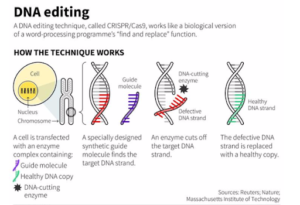In news– Recently, the Central government has paved the way for easy introduction of genome edited crops
Key updates-
- The Environment Ministry has notified fresh guidelines related to genome editing.
- The notification has exempted SDN 1 and SDN 2 genome and instead it would rely on reports of the Institutional Biosafety Committee to exclude exogenous genetic material.
- The institutional biosafety committees are expert committees constituted to deal with research and release of GM material.
- Such committees would now be entrusted to certify that the genome edited crop is devoid of any foreign DNA.
- In India, the introduction of GM crops is a laborious process which involves multiple levels of checks.
- The Genetic Engineering Appraisal Committee (GEAC), a high power committee under the Ministry of Environment, Forest and Climate Change, is the regulator for introduction of any GM material and in case of agriculture multiple field trials, data about biosafety and other information is necessary for getting the nod before commercial release of any GM crop.
- Till date the only crop which has crossed the regulatory red tape is Bt cotton.
- Now this would be a less cumbersome and time consuming process for commercial release of genome edited crops.
What is genome editing technology?
- Genome editing (also called gene editing) is a group of technologies that lets scientists change the DNA of many organisms, including plants, bacteria, and animals.
- A decade ago, scientists in Germany and the US discovered a technique which allowed them to ‘cut’ DNA strands and edit genes.
- For agriculture scientists this process allowed them to bring about desired changes in the genome by using site directed nuclease (SDN) or sequence specific nuclease (SSN).
- Nuclease is an enzyme which cleaves through nucleic acid — the building block of genetic material.
- Advanced research has allowed scientists to develop the highly effective clustered regularly interspaced palindromic repeat (CRISPR) -associated proteins based systems.
- This system allows for targeted intervention at the genome sequence.
- Using this tool, agricultural scientists can now edit the genome to insert specific traits in the gene sequence.
- Depending on the nature of the edit that is carried out, the process is divided into three categories — SDN 1, SDN 2 and SDN 3.
- SDN1 introduces changes in the host genome’s DNA through small insertions/deletions without introduction of foreign genetic material.
- In the case of SDN 2, the edit involves using a small DNA template to generate specific changes. Both these processes do not involve alien genetic material and the end result is indistinguishable from conventionally bred crop varieties.
- On the other hand, SDN3 process involves larger DNA elements or full length genes of foreign origin which makes it similar to Genetically modified organisms (GMO) development.

How is gene editing different from GMO development?
- Genetically modified organisms (GMO) involves modification of the genetic material of the host by introduction of a foreign genetic material.
- In the case of agriculture, soil bacteria is the best mining source for such genes which are then inserted into the host genome using genetic engineering.
- For example, in case of cotton, introduction of genes cry1Ac and cry2Ab mined from the soil bacterium Bacillus Thuringiensis (BT) allow the native cotton plant to generate endotoxins to fight pink bollworm naturally.
- BT Cotton uses this advantage to help farmers naturally fight pink bollworm which is the most common pest for cotton farmers.
- The basic difference between genome editing and genetic engineering is that while the former does not involve the introduction of foreign genetic material, the latter does.
- In the case of agriculture, both the techniques aim to generate variants which are better yielding and more resistant to biotic and abiotic stress.
- Before the advent of genetic engineering, such variety improvement was done through selective breeding which involved carefully crossing plants with specific traits to produce the desired trait in the offspring.
- Globally, European Union countries have bracketed genome edited crops with GM crops. Countries like Argentina, Israel, US, Canada, etc have liberal regulations for genome edited crops.
















